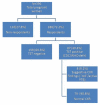Latent tuberculosis among pregnant mothers in a resource poor setting in Northern Tanzania: a cross-sectional study
- PMID: 20205938
- PMCID: PMC2846946
- DOI: 10.1186/1471-2334-10-52
Latent tuberculosis among pregnant mothers in a resource poor setting in Northern Tanzania: a cross-sectional study
Abstract
Background: Untreated latent TB infection (LTBI) is a significant risk factor for active pulmonary tuberculosis, hence predisposing to adverse pregnancy outcomes and mother to child transmission. The prevalence of latent tuberculosis in pregnancy and its association, if any, with various socio-demographic, obstetric and clinical characteristics was evaluated.
Methods: Northern Tanzania was chosen as the study site. In a cross-sectional study, a total of 286 pregnant women from 12 weeks gestational age to term were assessed. Screening was undertaken using an algorithm involving tuberculin skin testing, symptom screening in the form of a questionnaire, sputum testing for acid fast bacilli followed by shielded chest X-rays if indicated. HIV serology was also performed on consenting participants.
Results: Prevalence of latent infection ranged between 26.2% and 37.4% while HIV sero prevalence was 4.5%. After multivariate logistic analysis it was found that age, parity, body mass index, gestational age, and HIV sero status did not have any significant association with tuberculin skin test results. However certain ethnic groups were found to be less vulnerable to LTBI as compared to others (Chi square = 10.55, p = 0.03). All sputum smears for acid fast bacilli were negative.
Conclusion: The prevalence of latent tuberculosis in pregnant women was found to be relatively high compared to that of the general population. In endemic areas, socio-demographic parameters alone are rarely adequate in identifying women susceptible to TB infection; therefore targeted screening should be conducted for all pregnant women at high risk for activation (especially HIV positive women). As opposed to the current policy of passive case detection, there appears to be an imminent need to move towards active screening. Ethnicity may provide important clues into genetic and cultural differences which predispose to latent tuberculosis, and is worth exploring further.
Figures
References
-
- World Health Organization (WHO) Global tuberculosis control surveillance, planning, financing. WHO report 2006. Geneva: WHO. 2006.
-
- Wilkinson D, Davies GR. The increasing burden of tuberculosis in rural South Africa - the impact of the HIV-1 epidemic. S Afr Med J. 1997;87:447–450. - PubMed
Publication types
MeSH terms
LinkOut - more resources
Full Text Sources
Research Materials



